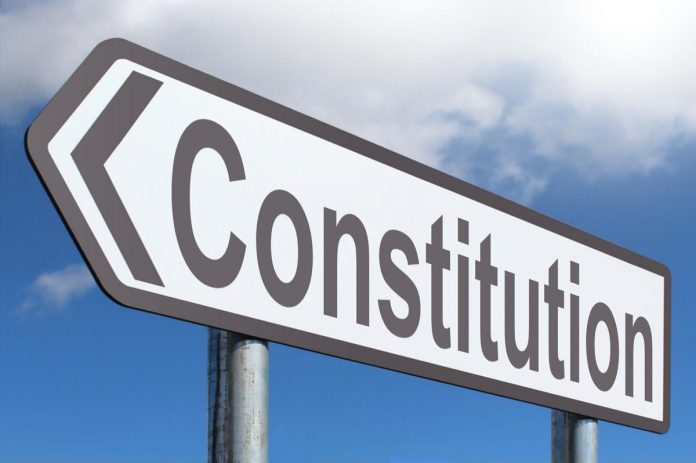This article is written by R Sai Gayatri from Post Graduate College of Law, Osmania University. This article explains the doctrine of Stare Decisis in detail along with case laws. The position of the doctrine of Stare Decisis in India as per the Constitution of India has also been discussed.
Table of Contents
Introduction
The term ‘Stare Decisis’ originates from Latin. It means ‘to abide by things decided.’ The doctrine of Stare Decisis is used by all courts in all cases/legal issues. A doctrine is nothing but a principle or instruction, however, it is not essentially a hard and fast rule that can not be broken. For instance, if the Supreme Court passes a judgement and it becomes a precedent, then as per the doctrine of Stare Decisis, the lower courts must follow such a judgement. The same principle has been mentioned in Article 141 of the Constitution.
The doctrine of Stare Decisis means that courts refer to the previous, similar legal issues to guide their decisions. Such previous decisions that courts refer to are known as “precedents”. Precedents are legal principles or rules that are created by the decisions given by courts. Such decisions become an authority or an example for the judges to decide similar legal cases/issues in the future. The doctrine of Stare Decisis creates an obligation on courts to refer to precedents when taking a certain decision. Let us know more about the doctrine of Stare Decisis through this article.
Essential objectives of the doctrine of Stare Decisis
The doctrine of Stare Decisis refers to the concept that courts must follow previously made judicial decisions in cases where the same legal issues are brought before them in subsequent matters. The concept of Stare Decisis aims to pursue four essential objectives, they are as follows –
- The doctrine of Stare Decisis builds confidence amongst the people in planning their economic and social transactions by acknowledging that their actions are in compliance with the law.
- The doctrine of Stare Decisis encourages the private resolution of disputes as the court may give its decision based on the decision of a similar previously decided case or legal issue. Since the parties to an issue already know the outcome of a similar legal issue, they might look for private dispute resolution rather than going through the conventional court procedure.
- The doctrine of Stare Decisis reduces the burden on the courts as well. It eliminates the requirement to litigate again in the cases wherein the decisions have already been given. It also curbs the need for fresh litigation whenever the judge/bench changes.
- The doctrine of Stare Decisis strengthens the confidence of the people in the judiciary as the said doctrine establishes certain restrictions and constraints on the powers of the judges. For instance, the doctrine of Stare Decisis requires the judges to decide legal matters before them in a foreseeable and rational manner.
The doctrine of Stare Decisis is premised on the maintenance of certainty, stability and consistency in the legal system. A precedent interests the primary need in a legal system which includes the factors of regularity, rationality and stability. The said doctrine ensures that a legal issue is resolved based on the previously decided cases irrespective of the judiciary and its jurisdiction. In the case of Hari Singh v. the State of Haryana (1993), it was held that in a judicial system that is administered by courts, one of the primary principles to keep note of is that the courts under the same jurisdiction must have similar opinions regarding similar legal questions, issues and circumstances. If opinions given on similar legal issues are inconsistent then instead of achieving harmony in the judicial systems, it will result in judicial chaos. The decision regarding a particular case that has been held for a long time cannot be disturbed merely because of the possibility of the existence of another view.
Further, in the case of ICICI Bank v. Municipal Corporation of Greater Bombay (2005), it was held that the decision given by the Apex Court must be read following the context of the statutory provisions which have been interpreted by the competent court. It was also stated that no judgement can be read if it is a statute. Since the law cannot always be static, based on the relevant principles and rules, the Judges must cautiously make use of the precedents in deciding cases.
Illustration on the doctrine of Stare Decisis
Let us assume that James borrows Bond’s bike while James is on a holiday. Bond does not ask James for permission to borrow his bike. Bond accidentally crashes and breaks James’s bike, but he does not tell James about it. Later, Bond simply places back James’s bike at James’s garage. When James returns home and discovers his broken bike, he demands that Bond must buy him a new one. The two bring their issue before the court, and the Court decides in favour of James stating that Bond is liable and owes James the money required for James to fix his bike, however, Bond does not have to buy James a new bike.
The aforesaid judgement given by the court now becomes precedent. Now onwards, based on the precedent established in this case, the lower courts in the same jurisdiction must abide by this new rule i.e., whenever a borrower breaks a thing or an item belonging to a borrowee and such borrower was using the borrowee’s thing or item without the permission of the borrowee in the first place, then the borrower is liable to pay as far as the damages done by them to the borrowee’s item. The lower courts must follow this newly established precedent because the doctrine of Stare Decisis obligates them to do so.
Effect of precedents on future decisions of courts
The doctrine of Stare Decisis is favoured in judicial systems because it encourages predictable, impartial and consistent development of legal principles, the said doctrine also promotes reliance on judicial decisions and contributes to the actual and perceived integrity of the judicial process. Stare Decisis aims to ensure that the public is guided in its personal and professional transactions by previously given court decisions, through established rules and principles. Stare Decisis reflects a concept wherein the applicable rule of law must be settled rather than that it be settled right. Further, the doctrine of Stare Decisis abides by the application of decision-making in a consistent and certain manner which in turn reflects in our legal culture and it is a prima facie display of the belief that such decision-making consistency has a normative value within itself.
The doctrine of Stare Decisis allows the public to presume that the foundational principles are rooted in the law rather than in the bias of the individuals and thereby the said doctrine contributes to the integrity of our judicial system and the government in the branches of application and sustainability. The doctrine of Stare Decisis is indispensable when it comes to the judicial system because it ensures unbiased adjudication and the predictability and certainty of law.
Advantages and disadvantages of the doctrine of Stare Decisis
Like every coin has its two sides, the doctrine of Stare Decisis also has its advantages and disadvantages. They are as follows –
Advantages of the doctrine of Stare Decisis
- The doctrine of Stare Decisis reduces the need for successive litigation and it further saves time and energy of the judiciary as it is not required to determine the same question of law or any legal issue repeatedly if it has been previously settled in some other case.
- When it comes to deciding a question of law it is often witnessed that there is a huge possibility of arbitrariness and bias trying to creep in. The doctrine of Stare Decisis curbs such unwanted and vicious elements from affecting fair and reasonable adjudication by obligating the judges to abide by the established precedents thereby preventing any kind of arbitrariness or bias.
- The element of predictability is one of the primary needs in the efficient functioning of a judicial system. The doctrine of Stare Decisis thus ensures that the judgements given by the courts are predictable thereby boosting the confidence of the people in the judicial system.
- The doctrine of Stare Decisis inculcates flexibility in the law. It can further be said that, by the virtue of the said doctrine, the law is moulded as per the social, cultural, economic and other circumstances.
- The doctrine of Stare Decisis also brings stability, certainty and consistency in the law. The said doctrine not only helps in the smooth operation of the judiciary but also records the application of law in deciding cases.
Disadvantages of the doctrine of Stare Decisis
- The doctrine of Stare Decisis may lead to the preservation and propagation of certain cases which might have been judged wrongly. It cannot be denied that there is a possibility of the existence of some case that has been decided in an arbitrary manner and because of the doctrine of Stare Decisis such case will be given primary importance at the expense of an aggrieved party.
- The doctrine of Stare Decisis is also considered as a doctrine that is against the principles of democracy since it allows unelected judges to make law through their judgements.
- The doctrine of Stare Decisis can also be supporting erroneous precedents that are moderately inconsistent with the Constitution, however, such error in the interpretation may be propagated and increased by further judgements premised on such precedent until such an interpretation is made out that contradicts the original understanding of the Constitution.
- Sometimes the doctrine of Stare Decisis is applied in a biased manner by particular judges in order to amend the precedents regarding which they might have had a dissenting opinion.
- The doctrine of Stare Decisis can also greatly hinder the all-around development of the law. As society and its ideologies change and as per the requirement of each legal question, there must be some reasonable variation in the approach towards the application of the law. The said doctrine basically echoes the concept of “one size fits all” i.e., it is not static in nature. Thus, the said doctrine might greatly affect the proper interpretation of the law as per the changing cultural, social, economic and other circumstances.
Position of the doctrine of Stare Decisis in India
The doctrine of Stare Decisis did not exist in India during the ancient or mediaeval period. It was only during the advent of British rule in the country that the concept of binding precedent was introduced and applied in India. The adoption of the doctrine of Stare Decisis was suggested by Dorin in the year 1813. The British legal establishment led to the concept of the hierarchy of courts along with the reporting of decisions, these two elements are the preconditions for the functioning of the doctrine of Stare Decisis.
The Britishers established the Sardar Diwani Adalats and the Supreme Courts at Calcutta, Bombay and Madras. The High Court Act, 1861 was enacted enabling the establishment of High Courts by the issue of letters of patent. Such High Courts had original and appellate jurisdiction. Therefore, a system of hierarchy of courts was established by the Britishers.
The Government of India Act, 1935 distinctly made the decisions of the Federal Court and the Privy Council binding on all courts in British India and in this way the doctrine of Stare Decisis gained statutory recognition in India. However, the Federal Courts were not bound by their own decisions. Post-independence, the doctrine of precedent continues to be followed in India.
Article 141 of the Constitution of India, 1950 establishes that the ‘law declared’ by the Supreme Court of India is binding on all courts within the territory of India. The term ‘law declared’ implies the law-making role of the Supreme Court. However, the Supreme Court is not bound by its own decisions. In Bengal Immunity Co. v. the State of Bihar (1955), the Apex Court held that there is nothing in the Indian Constitution that prevents the Supreme Court from departing from its own previously made decision if it is convinced of its error and the detrimental effect such decision might have on public interest. As far as the High Courts are concerned, the decisions of the High Courts are binding on all subordinate courts within the jurisdiction of such High Courts. In the case of Suganthi Suresh Kumar v. Jagdeesham (2002), the Apex Court held that a High Court does not have the permission to overrule the decision given by the Supreme Court merely based on the ground that such decision given by the Supreme Court had laid down principles without considering any of the legal factors. Further, in the case of Pandurang Kalu Patil v. State of Maharashtra (2002), the Supreme Court had further reiterated that the decisions of the High Court shall be binding until the Supreme Court overrules them.
Doctrine of Stare Decisis under Article 141 of the Indian Constitution
The Constitution of India, 1950 under Article 141 states that when the Supreme Court declares any law then such law shall be binding on all courts that are within the territory of India. Article 141 further states that the ratio decidendi of a case shall be binding and not the obiter dicta or the facts of the case. Thus, whenever a lower court wants to follow or apply the decision of the Supreme Court, the law laid down by the Apex Court in such a decision must be interpreted correctly in the case at hand.
Binding nature of the doctrine of Stare Decisis under Article 141 of the Indian Constitution
- All the courts within the territory of India are bound by the law to abide by the decision of the Supreme Court. The lower courts are bound to hold a uniform and constant approach towards the principle of following such a decision given by the Apex Court.
- The Supreme Court is however not restricted or bonded by its own judgement or decision. Even special leave petitions are also binding in nature, they must be followed by the lower courts. The reasons such as mere procedural irregularity or immateriality do not alone invalidate the binding nature of the judgement or decision.
- A judgement passed by the higher court can be considered as a precedent by the lower courts if and only when such judgement is capable of resolving a legal matter.
- The decision given by the court must be read together as a whole. Further, the observations from such a decision given by a higher court must be determined in accordance with the questions presented before the court.
- In certain cases, the bench might be of different opinions and in such cases, the opinion that has the support of the majority shall prevail as a precedent. In the case of Siddharam Satlingappa Mhetre v. State of Maharashtra and Others. (2011), it was held by the Apex Court that the judgement of a bench that is larger in strength shall be binding not only on a judgement of a bench smaller in strength but also on a Bench of Judges of co-equal strength.
- The cases where the Supreme Court has pronounced ex-parte decisions, even though one of the parties to the case was not present, still such decisions can be considered as a precedent.
Non-binding nature under Article 141 of the Indian Constitution
- The decisions that are not expressed properly. In the case of State v. Synthetics and Chemicals Ltd. and Anr. (1991), it was stated that a decision that lacks expression and rational grounds and further where it did not proceed on consideration of the legal issue, such decision shall not have a binding effect as per Article 141 of the Constitution of India.
- The decisions that are not founded on appropriate grounds.
- The decisions that did not proceed based on consideration of the legal issue. In the case of Dr. Shah Faesal and Others v. Union Of India and Another (2020), it was observed by the Supreme Court that only the principle laid down in a judgement shall be considered as binding law under Article 141 of the Constitution.
- As per the doctrine of Stare Decisis, the Obiter dicta of a case is not binding, thus it cannot be considered solely as a reason to declare any statutory rule invalid. It only has a persuasive value.
- The decision rendered per incuriam is not binding in nature. This means any decision made on per incuriam, must not be used as a precedent.
- In the case wherein the decision is rendered sub-silentio, even then such decision is not used as a precedent. Sub-silentio means when a question of law was not correctly and reasonably determined.
- The scenario wherein the Court’s observations regarding the facts of the cases are not binding.
Types of judicial precedents
- Declaratory precedent – A declaratory precedent refers to such a precedent wherein an already existing rule is applied in deciding a question of law.
- Original precedent – In the case of an original precedent, a new law is established to apply it in a legal issue. It can be said that the original precedents are primarily the reason for the making of new laws.
- Persuasive Precedent – A persuasive precedent is a kind of precedent wherein there is no compulsion for the judge to abide by a certain precedent regarding a legal issue, however, such a judge has the responsibility to consider the precedent before taking any action.
- Absolutely Authoritative Precedents – In the case of an absolutely authoritative precedent, it is a mandate for the judges to follow a particular precedent in deciding a legal matter. Moreover, the judge must abide by the precedent even if they have a dissenting opinion regarding such precedent.
- Conditionally Authoritative Precedents – When it comes to the case of conditionally authoritative precedents, the concerned judge has to follow the authoritative precedent as it is, but in certain special cases. A judge may disregard the decision of a court if it fails to be rational and lawful.
Precedents and treatment by Higher Courts
For a case that has been earlier decided by a lower court, a higher court can do the following –
- Reversal of decision – By order of a higher court, the judgement of the lower courts shall cease to have any effect on the parties or the public.
- Refusal to follow a decision – A High Court has the power to refuse to follow the decision of a lower court in cases where the High Court cannot reverse or overrule the lower court’s decision.
- Distinguish from the decision – Where a High Court finds that the material facts of the case differ and the principles decided in the precedence is extremely narrow to be adequately applied to the facts of the case before it, then the High Court may distinguish such case from the previously given decision by the lower court.
- Overrule of decision – In a situation where a High Court decides that the decision taken by the lower court regarding a particular is wrong, then it overrules such decision of the lower court.
Doctrine of prospective overruling
Generally, the courts follow the doctrine of Stare Decisis, however, the higher courts may overrule the decisions that may be arbitrary, erroneous or which are not applicable to the facts of the new case. The court may also overrule a decision where there is divided opinion.
Further, a court can overrule a decision where such a decision is vague, lacks clarity or causes inconvenience and hardship or the error in the prior decision cannot be easily corrected only with the help of the legislative process. When an earlier decision is overruled, it no longer is a binding precedent. In a case of overruling the decision of a previous case, the re-opening of old disputes on the ground of a change in the legal standing may arise, as a consequence, a multiplicity of proceedings may also arise.
Conclusion
The statutes and enactments of the legislature lay down the rules to be applied in the adjudication of disputes between parties and the final authority for the interpretation of these rules is the judiciary. The doctrine of Stare Decisis makes the decisions of courts, generally, the higher courts, binding on the subordinate courts in cases wherein similar questions of law are brought before the court. The applicability of the said doctrine ensures that there is predictability and certainty within the law. The said doctrine saves the time, energy and efforts of the judiciary and helps in eliminating the arbitrary and biased action on part of the judges. The doctrine of Stare Decisis is therefore within the interest of public policy and it creates confidence in the public by ensuring that their actions are in accordance with the law.
References
- http://ijtr.nic.in/webjournal/8.htm
- https://www.advocateshah.com/blog/what-is-stare-decisis-with-doctrine-of-stare-decisis/#:~:text=Decision%20taken%20by%20a%20higher,stand%20by%20the%20decided%20matters.
- https://corporatefinanceinstitute.com/resources/knowledge/other/stare-decisis/
Students of Lawsikho courses regularly produce writing assignments and work on practical exercises as a part of their coursework and develop themselves in real-life practical skills.
LawSikho has created a telegram group for exchanging legal knowledge, referrals, and various opportunities. You can click on this link and join:
Follow us on Instagram and subscribe to our YouTube channel for more amazing legal content.
 Serato DJ Crack 2025Serato DJ PRO Crack
Serato DJ Crack 2025Serato DJ PRO Crack











 Allow notifications
Allow notifications



